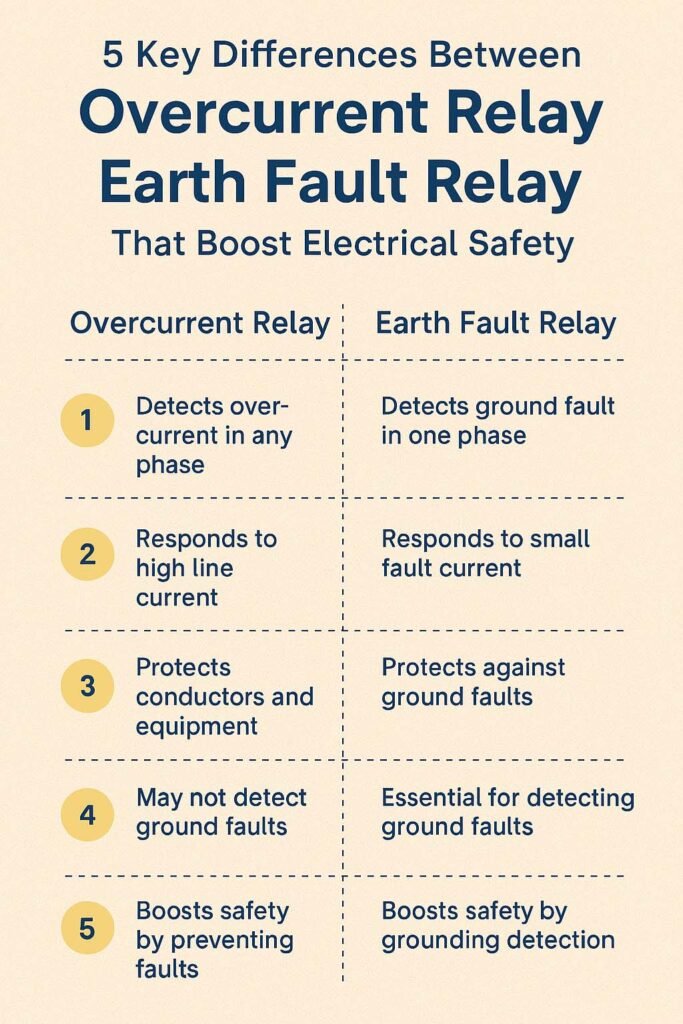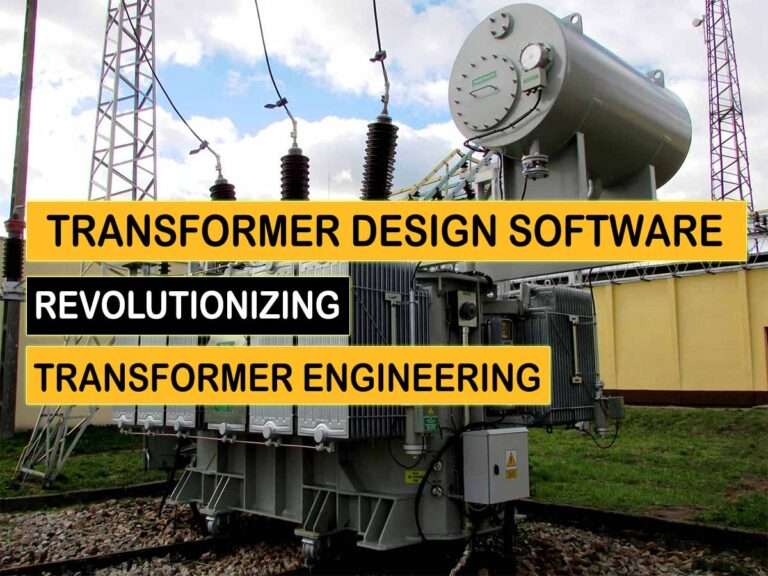5 Key Differences Between Overcurrent and Earth Fault Relay That Boost Electrical Safety
Electrical safety is a cornerstone of any power system. Protection devices, like relays, are designed to detect abnormal conditions and isolate faulty sections. Among them, overcurrent relays and earth fault relays play vital roles. Understanding their differences is crucial for engineers, technicians, and anyone involved in power system design or maintenance. This article explores the differences between overcurrent and earth fault relay in a clear, technical, and practical manner.

Table of Contents
What is an Overcurrent Relay?
An overcurrent relay is a protective device that operates when the current exceeds a predetermined value. It is widely used in power systems to safeguard equipment against overloads and short circuits. Overcurrent relays can be classified as:
- Instantaneous overcurrent relay (IOC): Trips immediately when the current exceeds the set value.
- Time overcurrent relay (TOC): Trips after a preset time delay depending on the magnitude of the current.
The operating principle of an overcurrent relay is simple: it measures the line current, compares it with the set current, and activates the trip circuit when the current exceeds the threshold. Learn in detail on vfd overload current setting
Equation for overcurrent detection:

Here, (I_{fault}) is the measured current and (I_{set}) is the relay setting.
What is an Earth Fault Relay?
An earth fault relay, also called a ground fault relay, detects leakage currents to earth. These currents may occur due to insulation failure, moisture, or accidental contact. The earth fault relay helps prevent equipment damage and electric shock hazards by isolating the affected circuit.
Earth fault relays can be classified as:
- Phase-to-earth relay: Detects leakage from any phase to ground.
- Neutral earth relay: Monitors the neutral point for unbalanced currents.
Equation for earth fault detection:

Here, (I_R), (I_Y), and (I_B) are currents in the three phases. If (I_{residual}) exceeds the set value, the relay operates.
Dive deeper into differential protection of alternator
1. Operating Principle
The primary difference between overcurrent and earth fault relay lies in their operating principle.
| Feature | Overcurrent Relay | Earth Fault Relay |
|---|---|---|
| Detection basis | Magnitude of line current | Residual current (sum of phase currents) |
| Trigger condition | Current exceeds preset limit | Current leakage to earth exceeds set value |
| Fault type addressed | Overload, short circuit | Ground fault, insulation failure |
While the overcurrent relay focuses on excessive line current, the earth fault relay targets leakage current. This distinction is vital for accurate protection coordination.
2. Types of Faults Covered
Understanding the types of faults each relay covers helps in designing an effective protection scheme.
| Fault Type | Overcurrent Relay | Earth Fault Relay |
|---|---|---|
| Overload | Yes | No |
| Phase-to-phase short circuit | Yes | No |
| Phase-to-earth fault | Partial | Yes |
| Insulation breakdown | No | Yes |
Overcurrent relays are ideal for high-current faults, whereas earth fault relays detect faults that may not generate high current but are dangerous for safety.
Learn more about types of generator protection relays
3. Sensitivity and Settings
Overcurrent and earth fault relays differ in sensitivity and setting parameters.
Overcurrent Relay Settings:
- Pick-up current (I_set)
- Time dial setting (TDS) for inverse-time characteristics
Earth Fault Relay Settings:
- Ground current pick-up ((I_residual, set)
- Time delay (optional for selective coordination)
Earth fault relays are generally more sensitive because ground faults can occur with lower current. For instance, a 500 A overcurrent may not trigger an earth fault relay if there’s minimal leakage, but even a 10 A leakage can activate it.
4. Applications in Power Systems
Both relays are used in different sections of power systems depending on their protection purpose.
Overcurrent Relay Applications:
- Protecting transformers, feeders, and generators from overload
- Short-circuit protection in distribution networks
Earth Fault Relay Applications:
- Protecting equipment from insulation failures
- Detecting leakage in industrial panels, cables, and switchgear
- Preventing electric shock hazards
The combination of both relays ensures comprehensive protection.
Get complete information about protection of alternator
5. Coordination and Selectivity
Coordination between relays is essential to isolate only the faulty section and maintain system stability.
Overcurrent Relay Coordination:
- Usually coordinated with upstream and downstream relays to ensure selective tripping
- Time-current characteristic curves help in grading
Earth Fault Relay Coordination:
- Often set with lower pick-up than overcurrent relays to ensure quick operation
- May include intentional time delay to coordinate with upstream devices
Proper coordination avoids nuisance tripping and ensures faster fault clearance, which improves overall safety.
Key Technical Considerations
Residual Current Calculation: For earth fault relays, accurate measurement of (I_{residual}) ensures proper detection.
Inverse Time Characteristics: Overcurrent relays often use inverse-time curves where trip time decreases with increasing fault current:

Here, (k) and (n) are relay constants.
Sensitivity Adjustment: Earth fault relays require precise current transformers (CTs) to measure low leakage currents.
Know more about alternator protection scheme
Summary Table of Differences Between Overcurrent and Earth Fault Relay
| Parameter | Overcurrent Relay | Earth Fault Relay |
|---|---|---|
| Function | Protects against high current | Protects against leakage current |
| Triggered by | Excess current in phase | Residual current to earth |
| Fault types | Overload, short circuit | Ground fault, insulation failure |
| Sensitivity | Moderate | High |
| Settings | Pick-up current, time delay | Ground current, optional time delay |
| Applications | Transformers, feeders, generators | Industrial panels, cables, switchgear |
| Coordination | Graded with upstream and downstream relays | Fast action for safety, may include delay |
Conclusion
Understanding the differences between overcurrent and earth fault relay is essential for ensuring electrical safety in power systems. Overcurrent relays protect equipment from high currents caused by overloads and short circuits, while earth fault relays detect dangerous leakage currents to prevent damage and electric shock. By selecting the correct relay type, adjusting sensitivity, and coordinating settings, engineers can design a robust protection system that maximizes safety and minimizes downtime.
Explore details on IEC Standard for Differential Protection
Both relays are complementary. Implementing them together ensures that all types of faults are covered, providing comprehensive protection. Proper installation and regular testing further enhance system reliability. In today’s industrial and residential environments, knowing the subtle yet critical differences between these relays is no longer optional—it is a necessity for electrical safety.
Follow Us on Social:
Subscribe our Newsletter on Electrical Insights to get the latest updates in Electrical Engineering.
#OvercurrentRelay, #EarthFaultRelay, #RelayProtection, #ElectricalProtection, #PowerSystemSafety, #CircuitProtection, #ElectricalEngineering, #RelayDifference, #FaultDetection, #ElectricalSafety





